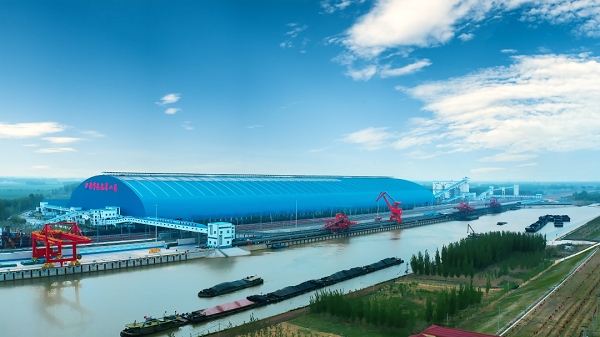Jining spurs high-quality shipping industry development
(chinadaily.com.cn)| Updated : 2022-08-17
Print Print
Coal is transported from the Liangshan Port Area of Jining Port to other parts of the country. [Photo/Jining News]
Jining, known as "an ancient city on the Beijing-Hangzhou Grand Canal", has fully used its geographical advantages to develop the port and shipping industry, aiming to build the largest inland river shipping center in northern China.
From January to June, Jining Port handled 28.32 million tons of cargos, up 30.2 percent year-on-year. The port's container throughput surged 168.9 percent year-on-year to 23,000 twenty-foot equivalent units (TEUs).
Jining Port has eight 2,000-tonnage berths, a 100,000-TEU container wharf and a steel-structure coal storage yard with the largest span in China.
The port is connected to the Belt and Road through the Watang-Rizhao Railway, and to the Yangtze River Delta region through the Grand Canal, forming a road-rail-water transportation network that includes the Beijing-Tianjin-Hebei region, the Yellow River economic area, the YRD region and the B&R.
Through upgraded waterways, 2,000-tonnage ships can directly sail from the Liangshan Port Area of Jining Port to the Yangtze River.
Since the beginning of this year, Jining has developed more than 40 upstream and downstream trade clients in 19 provinces across the country, and launched eight container routes, including one foreign trade route to Ho Chi Minh City, Vietnam.
The city has built a multimodal transportation logistics park, a container demonstration park and three port industrial parks.
The Jining Port and Shipping Development Group has also built a steel logistics processing base that has five operational production lines, which are capable of processing, storing and trading 500,000 tons of steel annually, and a shipping equipment and container production base that has 1,300 operational containers in major inland ports such as those in Wuhan, Hubei province and Changzhou, Jiangsu province.
A new energy ship maintenance and building base is expected to be completed by the end of this year and start production in 2023.

 Insights from the 10th Nishan Forum
Insights from the 10th Nishan Forum  Confucian culture thrives: Integrating its wisdom into modern value
Confucian culture thrives: Integrating its wisdom into modern value  Confucianism's enduring influence: Shaping East, Southeast Asian civilizations
Confucianism's enduring influence: Shaping East, Southeast Asian civilizations